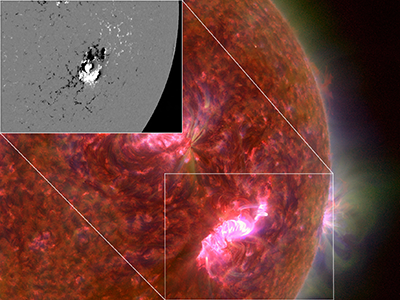Source: Space Weather
At some point in late 2018, the Parker Solar Probe will begin its first orbit around the Sun. The probe, which launched in August 2018, will fly through the Sun’s corona and maneuver closer to the star than any spacecraft has before.
The probe is venturing to the Sun to help scientists understand solar storms and space weather. These cosmic phenomena stem from magnetic fluctuations on the Sun’s surface and wreak havoc on Earth’s magnetic field. The storms impact agriculture, military activity, navigation technology, the electrical grid, and many other industrial sectors. Accurately predicting these events could help stave off the worst impacts of solar storms—and new research suggests there may be a way to do just that.

In a new study, Attie et al. describe a series of observations captured from 1 to 3 September 2017 that foreshadowed heightened solar and space weather activity. Looking in solar active region AR12673, the researchers noticed disturbances to the moat flow surrounding the region’s main sunspot several hours before the telltale magnetic flux that spawns solar storms. The moat flow is an outward flow of plasma that encircles a sunspot and forms a sooty shadow around its darkened core: The flow moves away from the center of the sunspot, like pancake batter expanding and flattening on a frying pan.
Using data from the Helioseismic and Magnetic Imager on board the Solar Dynamics Observatory and an automated algorithm applied for the first time, the researchers reported breaks in the moat boundary as its radius expanded prior to magnetic fluctuations around the sunspot. In some local instances, the moat radius expanded by 20% to 35%. The expanding moat boundary was also accompanied by a reduction in the velocity of escaping plasma. In the study’s focal zone, the changes to the moat boundary occurred between 2 and 12 hours before the magnetic disturbances.
These promising—but still exploratory—findings suggest that the topology of the moat may serve as a compass that points to regions of emerging magnetic flux. The authors were keen to note that they examined only one active region and that their hypothesis is still speculative. Nevertheless, the findings offer a new avenue of inquiry and may point to novel analyses of the Parker Solar Probe data. (Space Weather, doi.org/10.1029/2018SW001939, 2018)
—Aaron Sidder, Freelance Writer
Citation:
Sidder, A. (2018), Plasma activity around sunspots may foreshadow solar storms, Eos, 99, https://doi.org/10.1029/2018EO110921. Published on 05 December 2018.
Text © 2018. The authors. CC BY-NC-ND 3.0
Except where otherwise noted, images are subject to copyright. Any reuse without express permission from the copyright owner is prohibited.

